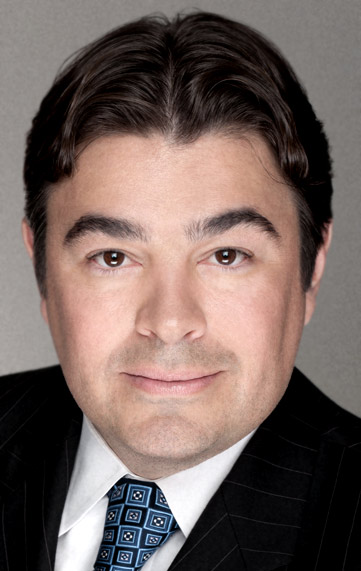

 During the recent ICANN Board meeting in Mexico City, the Board authorized the creation and funding of an Implementation Recommendation Team (IRT). This team was to be comprised of "an internationally diverse group of persons with knowledge, expertise, and experience in the fields of trademark, consumer protection, or competition law, and the interplay of trademarks and the domain name system to develop and propose solutions to the overarching issue of trademark protection in connection with the introduction of new gTLDs." more
During the recent ICANN Board meeting in Mexico City, the Board authorized the creation and funding of an Implementation Recommendation Team (IRT). This team was to be comprised of "an internationally diverse group of persons with knowledge, expertise, and experience in the fields of trademark, consumer protection, or competition law, and the interplay of trademarks and the domain name system to develop and propose solutions to the overarching issue of trademark protection in connection with the introduction of new gTLDs." more
 The U.S. is unusual in that grievants of a UDRP award have a statutory remedy from an adverse UDRP award, namely an action for declaratory judgement under the Anticybersquatting Consumer Protection Act (ACPA). The action is not an appeal, but a de novo assessment of the parties' rights, either that the domain name holder is cybersquatting or its registration was lawful. Under U.S. law UDRP awards are not treated as arbitration awards subject to the Federal Arbitration Act but as new disputes. more
The U.S. is unusual in that grievants of a UDRP award have a statutory remedy from an adverse UDRP award, namely an action for declaratory judgement under the Anticybersquatting Consumer Protection Act (ACPA). The action is not an appeal, but a de novo assessment of the parties' rights, either that the domain name holder is cybersquatting or its registration was lawful. Under U.S. law UDRP awards are not treated as arbitration awards subject to the Federal Arbitration Act but as new disputes. more
 The compliance deadline for the European Union's General Data Protection Regulation (GDPR) is nearly upon us, the unveiling of a proposed model to bring WHOIS into compliance is said to come from ICANN next week, and everyone is scrambling to understand all that's involved. Implementation of a revised WHOIS model is clearly on the horizon, but what comes after may be the real story! Specifically, if WHOIS information becomes more than nominally restricted, what's the consequence to the data controllers (ICANN and the contracted parties) who implement this revised model? more
The compliance deadline for the European Union's General Data Protection Regulation (GDPR) is nearly upon us, the unveiling of a proposed model to bring WHOIS into compliance is said to come from ICANN next week, and everyone is scrambling to understand all that's involved. Implementation of a revised WHOIS model is clearly on the horizon, but what comes after may be the real story! Specifically, if WHOIS information becomes more than nominally restricted, what's the consequence to the data controllers (ICANN and the contracted parties) who implement this revised model? more
 As the fall of 2012 begins the implementation of rights protection mechanisms (RPMs) for new gTLDs is reaching a critical stage... Given the half year interval between the upcoming Toronto ICANN meeting and the following Beijing meeting in April 2013, it is highly desirable, and perhaps essential, that community discussion in Toronto result in a clear consensus on how RPM implementation should proceed if new gTLDs are to launch without further delay and if potential registrants are to perceive them as acceptable platforms for speech and commerce. more
As the fall of 2012 begins the implementation of rights protection mechanisms (RPMs) for new gTLDs is reaching a critical stage... Given the half year interval between the upcoming Toronto ICANN meeting and the following Beijing meeting in April 2013, it is highly desirable, and perhaps essential, that community discussion in Toronto result in a clear consensus on how RPM implementation should proceed if new gTLDs are to launch without further delay and if potential registrants are to perceive them as acceptable platforms for speech and commerce. more
 We're in an interregnum where society has paused, and there's no telling how things may turn. In such times of crisis, we are the explorer; exploring the uncharted waters of change, where dangers and opportunities lie. How the pandemic caused this greater societal change may not be something that an individual can alter, we may, however, take the helm and navigate. more
We're in an interregnum where society has paused, and there's no telling how things may turn. In such times of crisis, we are the explorer; exploring the uncharted waters of change, where dangers and opportunities lie. How the pandemic caused this greater societal change may not be something that an individual can alter, we may, however, take the helm and navigate. more
 The UDRP is a forum of limited jurisdiction designed for trademark owners to combat a certain kind of tortious (sometimes tipping to criminal) conduct by which registrants register domain names with the bad faith intent of taking economic advantage of owner's marks and injuring consumers by beguiling them to disclose personal information. The forum is not open to trademark owners whose claims are outside its scope, even though they may include allegations of cybersquatting. more
The UDRP is a forum of limited jurisdiction designed for trademark owners to combat a certain kind of tortious (sometimes tipping to criminal) conduct by which registrants register domain names with the bad faith intent of taking economic advantage of owner's marks and injuring consumers by beguiling them to disclose personal information. The forum is not open to trademark owners whose claims are outside its scope, even though they may include allegations of cybersquatting. more
 UDRP complainants prevail in the range of 85% to 90% which approximately correlates with the percentage that respondents default in responding to complaints. The annual number of complaints administered by ICANN providers has been hovering around 4,000 +. Astonishingly, the number has remained steady for a good number of years despite the phenomenal increase... Compared to the whole, there are a relatively small number of contested disputes, perhaps in the annual range of 400 to 500, and of those a larger percentage are called out as cybersquatters. more
UDRP complainants prevail in the range of 85% to 90% which approximately correlates with the percentage that respondents default in responding to complaints. The annual number of complaints administered by ICANN providers has been hovering around 4,000 +. Astonishingly, the number has remained steady for a good number of years despite the phenomenal increase... Compared to the whole, there are a relatively small number of contested disputes, perhaps in the annual range of 400 to 500, and of those a larger percentage are called out as cybersquatters. more
 In my recent CircleID post, DNS, Domain Names, and Certificates: The Missing Links in Most Cybersecurity Risk Postures, I highlighted the importance of applying multiple layers of defense to secure these business-critical assets. Last Friday, Brian Krebs, the world-renowned cybersecurity journalist, reiterated the criticality of domain name security because the domain name "e-hawk.net" was stolen from the rightful owner using social engineering tactics targeting its domain name registrar. more
In my recent CircleID post, DNS, Domain Names, and Certificates: The Missing Links in Most Cybersecurity Risk Postures, I highlighted the importance of applying multiple layers of defense to secure these business-critical assets. Last Friday, Brian Krebs, the world-renowned cybersecurity journalist, reiterated the criticality of domain name security because the domain name "e-hawk.net" was stolen from the rightful owner using social engineering tactics targeting its domain name registrar. more
 Cyberflight (defined as strategically transferring accused domain names to another registrar or registrant upon receipt of a complaint) was a sufficient irritant by 2013 for the ICANN to adopt recommendations to amend the Rules of the Uniform Domain Name Dispute Resolution Policy (UDRP). Effective July 1, 2015 the Rules now include a requirement for locking the domain as well as a change in the timing of transmitting the complaint to respondents. Before the amendment there had been no uniform approach to locking. more
Cyberflight (defined as strategically transferring accused domain names to another registrar or registrant upon receipt of a complaint) was a sufficient irritant by 2013 for the ICANN to adopt recommendations to amend the Rules of the Uniform Domain Name Dispute Resolution Policy (UDRP). Effective July 1, 2015 the Rules now include a requirement for locking the domain as well as a change in the timing of transmitting the complaint to respondents. Before the amendment there had been no uniform approach to locking. more
 Domain brand squatting can be defined as the unauthorized or dishonest use of a brand or company identifiers in domain names. It is often linked to the use of look-alike domains in bad faith, and we see it all the time. The threat actors behind these domains are called different names, though a prevalent one would be “typosquatters.” The Hot on the Trail of Compulsive Brand Squatters webinar showcased how these people are infiltrating the Internet. The first page of PhishTank’s valid phish search alone as of this writing tells us that domain brand squatting is a real and present danger. more
Domain brand squatting can be defined as the unauthorized or dishonest use of a brand or company identifiers in domain names. It is often linked to the use of look-alike domains in bad faith, and we see it all the time. The threat actors behind these domains are called different names, though a prevalent one would be “typosquatters.” The Hot on the Trail of Compulsive Brand Squatters webinar showcased how these people are infiltrating the Internet. The first page of PhishTank’s valid phish search alone as of this writing tells us that domain brand squatting is a real and present danger. more
 The post reconsiders a cooperative solution to cybersquatting that I proposed in 2007. I also draw on examples of success and failure of legal actions to protect intellectual property (IP) licensing. Cybersquatting has gone unabated with the new gTLDs despite the introduction of new protection instruments such as the Trademark Cleaning House (TMCH) database and the availability of Uniform Rapid Suspension (URS) services, as well as declarations by registries of their intentions to block unauthorized registrations. more
The post reconsiders a cooperative solution to cybersquatting that I proposed in 2007. I also draw on examples of success and failure of legal actions to protect intellectual property (IP) licensing. Cybersquatting has gone unabated with the new gTLDs despite the introduction of new protection instruments such as the Trademark Cleaning House (TMCH) database and the availability of Uniform Rapid Suspension (URS) services, as well as declarations by registries of their intentions to block unauthorized registrations. more
 The weighing of evidence involves the connecting of dots, which involves drawing inferences. However, just as there can be false positives, there can be false inferences. The tendency may be to think of inferences as coming in one size, but not all inferences are logically correct. Some are weak and others strong. The reason for talking about both kinds is that so much depends on the quality of their making. more
The weighing of evidence involves the connecting of dots, which involves drawing inferences. However, just as there can be false positives, there can be false inferences. The tendency may be to think of inferences as coming in one size, but not all inferences are logically correct. Some are weak and others strong. The reason for talking about both kinds is that so much depends on the quality of their making. more
 Chanel's warning to counterfeiters: "we are watching and we are taking action." That's the literal message you will see when visiting around 40 websites that used to sell counterfeit goods (such as mychanelshop.com) that now redirect to the Chanel-owned website chanelreplica.com. These domains were transferred to Chanel as a result of a favorable decision rendered in May 2010 against two counterfeiters. more
Chanel's warning to counterfeiters: "we are watching and we are taking action." That's the literal message you will see when visiting around 40 websites that used to sell counterfeit goods (such as mychanelshop.com) that now redirect to the Chanel-owned website chanelreplica.com. These domains were transferred to Chanel as a result of a favorable decision rendered in May 2010 against two counterfeiters. more
 The World Intellectual Property Organization put out a release yesterday trumpeting an eight percent increase in domain name disputes handled by WIPO. In 2008 there were 2329 complaints filed with WIPO, the most ever. WIPO uses the increase to raise questions about the possible increase in the number of available generic top-level domains... more
The World Intellectual Property Organization put out a release yesterday trumpeting an eight percent increase in domain name disputes handled by WIPO. In 2008 there were 2329 complaints filed with WIPO, the most ever. WIPO uses the increase to raise questions about the possible increase in the number of available generic top-level domains... more
 Defendant Shui registered the domain name citybank.org and established a site there promoting financial services, sometimes using the mark CITIBANK. The real Citibank, armed with its trademark registrations in over 200 countries and over 50 years of use of its CITIBANK mark, filed suit against Shui under the Anticybersquatting and Consumer Protection Act, 15 USC 1125(d) ("ACPA")... Citibank sought $100,000 -- the maximum amount of statutory damages available under the ACPA, plus payment of Citibank's attorneys' fees... more
Defendant Shui registered the domain name citybank.org and established a site there promoting financial services, sometimes using the mark CITIBANK. The real Citibank, armed with its trademark registrations in over 200 countries and over 50 years of use of its CITIBANK mark, filed suit against Shui under the Anticybersquatting and Consumer Protection Act, 15 USC 1125(d) ("ACPA")... Citibank sought $100,000 -- the maximum amount of statutory damages available under the ACPA, plus payment of Citibank's attorneys' fees... more